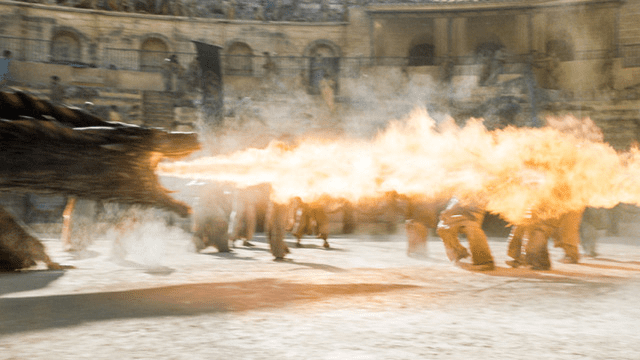*According to engineer Guy Gratton
Like many others, I am quite fascinated by the world of Westeros, where the inhabitants constantly debate about who is in charge. Game of Thrones is very captivating, but don’t get too attached to any character, because in the show, no one survives for long.
One of the most powerful characters – Daenerys Targaryen – spends a significant amount of time exploring the world and expanding her realm. As a mechanical engineer, I have noticed that the dragons in the show fly in a way that is quite different from how real-life dragons would operate.
It can be calculated that the weight of a dragon comparing to Daenerys, who is about 1.6 meters tall and weighs around 60 kg. The wingspan of the dragon could be quite long, with a wingspan of about 4 meters and a wing area equivalent to that of Daenerys. The weight supported by the dragon’s wings and body together would amount to approximately 44 times Daenerys’ weight: 2600 kg.
Assuming all characters in Westeros move similarly to us, the lift force would be the same, leading to the conclusion that the lift force of the dragon would be about W = 26,000 Newtons when the acceleration of gravity is 10 m/s².
If we want to analyze the aerodynamic properties of this dragon species, we need two pieces of information. One is the wing area. Each wing has an area equivalent to two rectangles measuring 4 meters and 8 meters, totaling an area of 64m2 denoted as S.
The second is the lift coefficient, or the lowest speed at which a dragon can fly without stalling. It can be inferred that dragon wings could produce lift at a minimum speed similar to that of airplanes and birds. Observing the footage, the dragon’s wingspan of 13 meters could allow it to traverse in 3 seconds, which implies a speed of about 4.3 m/s or 14 feet/s.
Aerodynamic Dragon Flight
As an engineer, when faced with a problem, I typically use calculations to solve it. In this case, I will utilize the basic lift equation:
If we consider the air density at sea level on Earth is p=1.2 kg/m3, we have a lift coefficient of 36, meaning the dragon cannot fly. I will organize it as follows:
The Rogallo wing is ultra-light – a wing with one or two spars forming a lightweight frame and a fabric covering that can generate lift. It has a lift coefficient ranging from 2.2 to 2.7. Certainly, advances in technology have helped dragon wings become more efficient, but I must assume a few conditions here, and I assume the maximum lift coefficient (CL.max) is 3.5.
The aerodynamic performance of the wings suggests that the air in Westeros is significantly different from what we have. Using the equation above, we can calculate the density of the lift:
12 kg/m3 is about 10 times the density of air on Earth, which sounds alarming, but in reality, it doesn’t reach such levels. The most striking difference is the experience of flying at an altitude of 100 meters – an altitude where the normal air density cannot be compared to anything.
There is another point that clarifies this. After watching a few episodes, one might think that anyone in the show could easily grab or throw something to the extent that an Olympic athlete would envy. With the lift force not changing, this suggests that the objects being thrown have a significantly higher energy than those on Earth – this completely aligns with the low air density.
What’s in the Air?
What exactly is in the air there? The air on Earth comprises 21% oxygen, 78% nitrogen, and 1% other gases. We know that 21% oxygen is the level at which you and I are currently breathing – but at about 30% concentration, this oxygen level can cause every organism to combust (at higher levels, it does not necessarily mean combustion but rather explosion). This could be a potential issue in Westeros, where anyone close to fire could ignite instantly, while local residents might be quite concerned about the possibility of spontaneous combustion when they live in a castle.
What about the remaining gases? I suspect they are not nitrogen like on Earth but rather argon – a rare gas that comes after nitrogen. Argon has a density that is significantly higher than nitrogen by about 42%, which could make the air denser while still maintaining a pressure below 10 bar.
There are two laws related to gases that we can use to determine the properties of the atmosphere in Westeros: Charles’s law and Boyle’s law. By applying these, we can deduce that at a pressure more than 7 times that of Earth and a gas composition of 70% argon/30% oxygen, the air density would be 12 kg/m3 and the dragon could fly. Simply put, we could create denser air by making it lighter – by substituting nitrogen with lighter gases like argon.
Moreover, this argon/oxygen (argox) mixture could potentially lead to increased pressure. This could very well cause tendencies of violent behavior among the inhabitants of Westeros.
With a bit of physics, aerodynamic forces, and human psychology, we can understand much more about Westeros – a place where the original cause of fire might be dragons, and the most common behavior of its people is not simply drunkenness but rather the effects of low-density air hitting them daily.
(According to Genk – Intellectual Property)


























